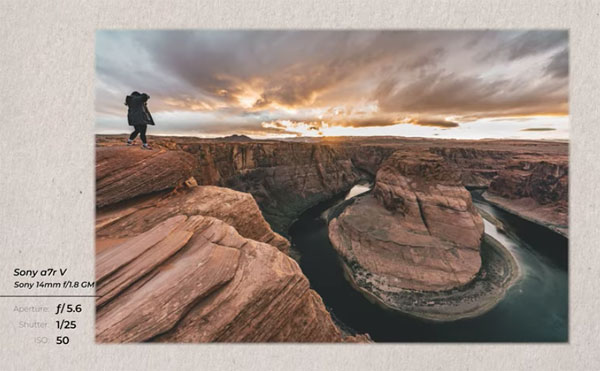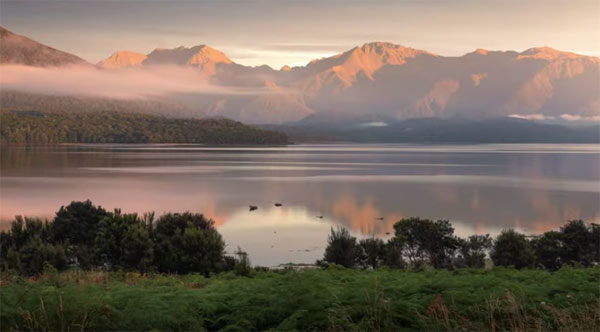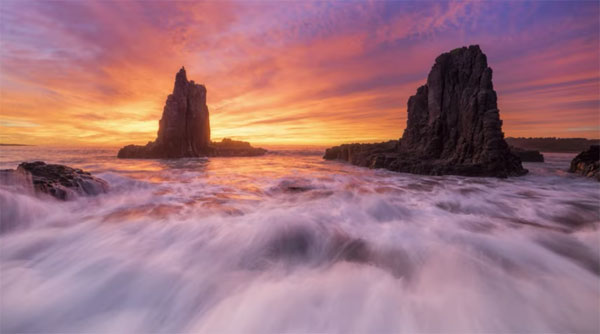5 tricks celebrity professional organisers, The Style Sisters, swear by when moving house
Following these tips could help alleviate even just a little bit of stress
Have you ever returned from a vacation to a popular city, or to an iconic destination in the great outdoors, only to realize that your images look pretty much the same as those shot by everyone else? In the quick tutorial below you’ll learn simple techniques that are guaranteed to make your photos stand out from the crowd.
The topic of this quick episode from B&H Photo Video is environmental portraiture. Whether you’re a travel photographer looking to go beyond typical tourist photos, or a landscape shooter interested in adding a person within the frame for more compelling results, this two-minute episode is just what you need.
Instructor Maria Perez is a photographer and video producer based on the east coast, and she’s here with some great tips on posing subjects within different scenes, choosing a lens with the best focal length for the job, and putting it all together with attention-grabbing composition.

This lesson includes several effective techniques when shooting with wide-angle, standard lenses (35mm-50mm), and telephotos zooms from 70-200mm to 200-600mm. Perez provides links to her favored gear in the description beneath the video. Some of the poses she demonstrates are dependent upon the specific lens you decide to use.
Wide-angles tend to be the first choice of landscape photographers because of he utility they provide for capturing expansive vistas, but they’re not often considered appropriate for shooting portraits. Perez quickly dispels this myth with some helpful tips and compelling examples.
Normal lenses are not thought of as wide enough for shooting landscapes, but Perez disagrees. She says, “they are amazing for capturing your portrait subject within that landscape,” and she illustrates how to get the job done. The obvious benefit here is that you can still tell a story with your photos, while capturing images that are different from most.

Perez wraps up the lesson by bringing out the big guns, ordinarily used for wildlife photography. She insists that long telephotos are also incredibly useful for “capturing some of the best door portraits.” After listening to Perez’ techniques and viewing her results, we think you’ll agree.
There’s much more to see on the B&H Photo Video YouTube channel, and we recommend visiting there often.
We also suggest checking out the tutorial we posted on a related subject, explaining a British pro’s secrets to capturing outdoor photos with perfect exposures.
We’ve posted countless landscape tutorials in the past—some with so-called “rules” of composition, and others with tips from top pros. And guess what? Many of these lessons include very similar advice.
Of course that’s not a bad thing because important concepts are worth revisiting. But in the tutorial below, a successful New Zealand pro takes a different approach. In fact, you could almost say he works backwards as compared to more conventional methods.
William Patino specializes in landscape photography, teaching shooting and editing techniques that often have a unique twist. In a sense Patino marches to his own drummer, as you’ll see in the five-minute composition tutorial below.

Along the way Patino reveals, “some embarrassing mistakes I used to make,” so you don’t make them yourself. But the real emphasis of this episode is a selection of Patino’s favorite tips, designed to help you shoot more compelling landscape images with depth, interest, and drama.
Patino begins with this warning that you probably haven’t heard before: “Whatever you do, please don’t set up your tripod straight away.” Hmmm. Sort of the opposite of what you’ve heard in the past, right?
Instead, upon arriving at a destination, Patino works more like a fly fisherman who leaves his rod in the case until he studies the stream, determines what bugs are hatching, and locates probable hiding sport for the “big ones.” In other words, Patino recommends leaving your gear in the bag, until you’ve strolled around (often walking backwards) and thoroughly examined the site.

With this thoughtful approach you’re far more likely to locate an ideal subject, and only then is it time to examine the lenses in your bag to decide which one is best suited for the task. But it’s still not time to start shooting until you’ve carefully determined the intensity, quality, and direction of the light. Now, and only now, is it time to grab your camera.
After watching this video head over to Patino’s YouTube channel where you’ll find more interesting tips and tricks.
And don’t miss a tutorial we posted earlier, explaining how to shoot amazing landscape photos with your phone.

Desert sand verbena and brown-eyed primrose with Coyote Mountain in the background at Anza-Borrego Desert State Park.
Colorful wildflowers announce a new year, new growth and freshness on the land. “Spring” wildflowers bloom not just in spring but throughout the fall in many regions of the country. Blooming depends on seasonal weather, altitude, temperature, habitat and latitude.
I live in California, a state over 1,000 miles from north to south, blessed with all these elements. I can photograph wildflowers from early February through September. You can find similar situations in many regions of the country.
Join me as I go on the road in California to reveal the best spots to photograph wildflowers. I’ll also share tips with you on how to capture these colorful beauties at their best as they emerge in other parts of the country this spring.

Honey bee on Rocky Mountain Beeplant.
The deserts of Southern California produce the first spring wildflowers if winter rains cooperate. One of the earliest blooming areas is the low desert in Anza-Borrego Desert State Park. Wildflowers bloom here in February, and you will be amazed at the diversity of species. Dune primrose bloom among desert sand verbena, and the color combination makes great images. The park has a website with wildflower blooming information.
You can find sand verbena carpeting the desert floor. I captured an image that isolated just the expanse of flowers emphasizing the lushness of the new growth. But I also like to capture grand landscapes of the flowers and their habitat.
I recomposed to include Coyote Mountain in the background, an interesting contrast of arid desert and lush new growth. I used a low angle of view in these compositions to emphasize the wildflower elements.
Anza-Borrego Park is immense, and driving distances are significant. Plan a few days in Borrego Springs, a small town with all facilities in the park. When I find a field of flowers, I like to spend time capturing the different faces of the flowers, from wild-angle vast landscapes to macro detail. Plan on using a tripod and have lots of patience waiting for a break in the ever-present wind.
If you arrive in March or April, you can find a wide variety of cacti, which produce spectacular flowers. I usually spend a lot of time with one flowering cactus looking for different perspectives and ways to capture the flowers.

Lemmon’s paintbrush at Mammoth Overlook in the Eastern Sierras.
North of Anza-Borrego, Joshua Tree National Park is a vast, protected land of arid Colorado desert. The park is named for the Joshua trees that grow there. These “trees” are not your usual wildflower subject, but they produce spectacular white blooms. I photographed this tree with the buds just forming to emphasize an old, gnarled-looking tree still has life.
There are cactus gardens throughout the park. Go in March and April for the Joshua tree and cactus blooms. Another beautiful plant in the area is the ocotillo. During most of the year, they are spindly, dried-out branches. But in spring, they produce lush green leaves and brilliant red flowers. They make a great subject. I like to photograph the complete plant and include the arid surroundings. Then I turn to the flowers for intimate closeups. The plant supports insects and other wildlife, and I like to show their relationship.
The Santa Monica Mountains National Recreation Area in Los Angeles is a protected, wooded wonderland of trails, streams and wildflower opportunities. In spring, you may see spectacular wildflowers, like hummingbird sage and California mariposa lily.
Surprisingly, you can find orchids in the Santa Monica Mountains. Stream orchids grow in lightly shaded areas along ephemeral streams. Look closely along the banks.
In spring, following a wildfire burn now common in Southern California, wildflowers often spring up in large displays. Look for these displays surrounding charred remnants of plants and trees lost in the fire. Images like these lupine surrounding a burned tree stem contrast the fire devastation with the feel of new life signified by the wildflowers.

California poppies and wildflowers at sunrise at Lancaster Poppy Reserve.
In March or April, if winter rains were good, head for Lancaster Poppy Reserve (officially known as the Antelope Valley California Poppy Reserve State Natural Reserve) north of Los Angeles for spectacular wildflower photography. The diversity of flowers and color are outstanding. The Reserve sponsors wildflower days and has extensive information on species and locations.
Wander the area early in the morning to capture flowers before they open, then stick around for fully opened blooms for entirely different images like the cover image for this article, taken just a little later in the morning. Later morning light can be very harsh, so photograph as early as possible, when the poppies open.
These massive wildflower displays only occur every few years. If you are in the area, make sure you visit during a display. When wandering fields of flowers, PLEASE respect them and DO NOT tramp them down to get your image.
I wander around the wildflowers looking to isolate individual flowers for another perspective. Early in the morning, you can photograph the poppies just as they are about to open. Stay a while and capture images of the fully opened flower. It looks like a completely different species.

Pipevine swallowtail on desert thistle.
Wildflowers bloom depending on warming trends, so work your way north from Los Angles as the temperatures rise. In early June, head to the Eastern Sierras in California. Drive to the Eastern Sierras via U.S. Route 395 north of Los Angeles. Stop in the Alabama Hills, just west of Lone Pine, for high desert wildflowers. Wildflowers here are tiny, like desert calico and Parry’s gilia. The whole flower bouquets were 3 feet high. Walk carefully. This is “on your belly” photo time.
In the summer, head to Bishop in the Eastern Sierras via Route 395 north of Lone Pine. Take California State Route 168 west of Bishop into the Sierras for spectacular higher-altitude wildflowers. Stop along the highway for wildflower hikes. You could be rewarded with flowers like these Kelly’s tiger lilies. Bishop is a full-service town and a great location for photo day trips.
North of Bishop, on Route 395, take the California State Route 203 turnoff to Mammoth Lakes. Go through Mammoth Mountain ski area to the overlook. The view here is spectacular. In early summer, you may be able to capture grand landscapes of the distant Sierras with fields of Lemmon’s paintbrush in the foreground. Lemmon’s paintbrush are soft pink multi-petaled flowers worthy of isolated photographs of just the blossoms themselves. Use your wide-angle lens and get low to feature the wildflowers or a little higher to bring out the Sierras. Sunrise offers the best light.

California poppies and desert dandelions at Lancaster Poppy Reserve.
A great late summer to early fall location in northern California is Prairie Creek Redwoods State Park. Drive and hike the area for wildflowers like mountain iris. Multiple blooms or blooms in interesting spots make for unique images.
Lupine bloom throughout the park, and early summer is breeding time for birds. With a little luck, you might capture a male perched on colorful lupine singing to announce his territory.
Driving the back roads in California can be especially productive. I found several Rocky Mountain bee plants blooming along a dirt road. Wildflowers provide nectar and food for a variety of insects. Find a flower with insects buzzing, set up and wait. I photographed a honeybee visiting his namesake. I sat in my car and used a medium telephoto lens with shallow depth of field and a bean bag to stabilize my camera on the windowsill.
Another roadside gem was a stunning goatsbeard. Drive slowly, enjoy the scenery and watch for unique colors in the landscape. Or lock your car and wander. The scenery everywhere is beautiful.

Lazuli bunting on lupine in Prairie Creek Redwoods State Park.
Wildflowers are diverse, and so are the insects that feed on them. Butterflies on wildflowers make great images. Find an area where they are feeding, set up on a photogenic blossom and wait. Use a long telephoto lens with shallow depth of field to diffuse the background and give you distance from the butterfly. You might be rewarded with an image like this pipevine swallowtail.
Wildflowers are interesting, colorful, challenging subjects. Look for grand landscapes, isolated flowers, interaction with wildlife that depend on them for food, and abstract interpretations that challenge the viewer, like this closeup of cactus flower leaves. Animals feeding among wildflowers also make great wildflower/species interaction images.
Areas of wildflower diversity exist in all regions of all countries. Go out and wander. You will create beautiful images and be happy you did.
See more of Dave Welling’s work at strikingnatureimagesbydavewelling.com.
The post The Best Places To Photograph Spring Wildflowers appeared first on Outdoor Photographer.
